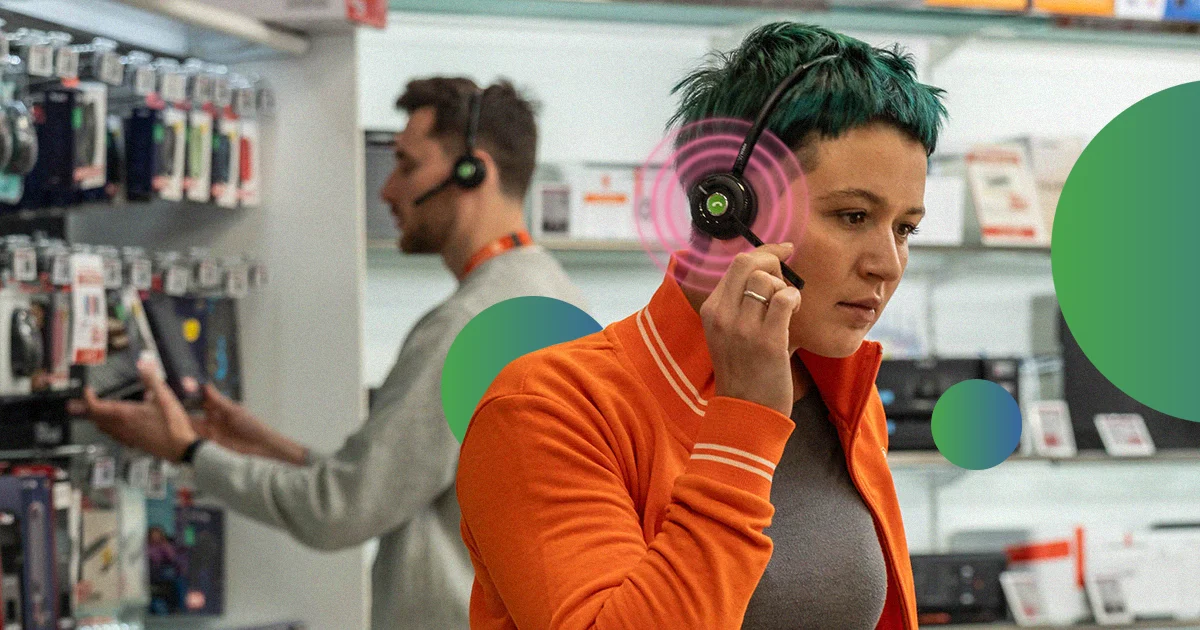But is it too fast? Have we all succumbed to the hype or is there actual measurable value in the marriage of retail and AI? And more importantly, will it positively or negatively change the in‑store shopping experience for good?
Let’s start by taking a closer look at the different types of retail artificial intelligence currently in use.
First and foremost, let’s not let generative AI steal the spotlight. Covering a wide range of technologies from computer vision to machine learning, AI for retail is constantly evolving in a quest to improve efficiency and free up store associates’ time so they can better serve customers.
The first thing that may come to mind when we mention robots and retail together is warehouse management. And it makes sense. Many physical but repetitive tasks have to be done in a warehouse that even narrow AI can handle, including sorting, picking, transport and inventory management — just to name a few. In fact, warehouses can even use drones to scan items and detect heat, allowing them to count stock and monitor temperature-sensitive items.
But while this technological application does impact the shop floor by ensuring items get to stores quickly, it’s invisible to customers. The same, however, cannot be said for store robots.
Usually found in grocery stores with googly eyes and as tall as the highest shelf, store robots slowly move down the aisles checking inventory and looking out for spills and other hazards. When they find something, they alert store associates by sending a notification over the public announcement (PA) system. And that’s it. That’s their main function.
Store robots are an interesting use of AI for retailers but they come with one major drawback, their size. Customers have to navigate shopping carts around them, and while they do use their sensors to pick up on this and move out of the way, they’re still perceived as a nuisance. And then there’s also the fact they serve as a visible reminder that they are physically replacing an employee — something that can also leave a negative impression of a store. However, just like the robotics used in warehouses, store robots successfully increase efficiency and allow store associates to do more customer-facing work.
Another interesting application of artificial intelligence in the retail industry is computer vision. Computer vision works by using neural networks to recognize images, allowing it to “see” things in a way similar to how we do. While the most common example can be found in modern car backup cameras, in the retail space store security cameras paired with computer vision can detect a number of things including theft attempts, falls, spills, waiting customers and gaps on shelves.
One of the main benefits of using a camera system to detect different events is that, depending on the age and sophistication of a store’s current cameras, all that needs to be added is the software. Customers are also accustomed to store cameras and are thus less likely to notice the change to the infrastructure. The only potential issue with this kind of solution is how the alerts are delivered. If they are sent to a web or mobile application, someone on the team will have their head down and focused on a screen to pick them up.
There’s an easy fix, however, depending on the system. Assuming the computer vision software has open APIs or is already integrated with a retail headset system, the alerts can be sent directly to store associates, allowing them to not only react quickly to any in‑store event but also do so discreetly. That way the only thing a shopper notices is that a helpful employee is on the case.
The only thing with IoT solutions is that they don’t just work out of the box. To get a system that truly improves how a store operates you have to build it, as rarely do two retailers have the same set of systems and devices. But, as long as the systems chosen have open APIs or ready-to-go integrations, it just takes a little extra thought and planning to create a solution an ideal solution.
Of course, the AI star of the hour is generative AI. For years, artificial intelligence in retail and elsewhere has mainly consisted of technology that can interpret what is already there or perform a very specific task. With generative AI, suddenly there’s a technology that can create, or at least do a very good job of predicting patterns, in text, images and video.
Of the different types of generative AI, it’s mostly ones focused on natural language processing with the most applications within a retail store. While some use cases, such as using gen AI to power chatbots, are customer-facing, the majority of early adopters are actually using the technology to assist their employees, who equally benefit from being able to ask queries in natural language instead of strict prompts.
With access to products like ChatGPT, store associates can quickly answer obscure or technical customer questions, check stock levels, find out what works well as an add-on product or even use it to upsell. It all depends on what data or knowledge base the gen AI model is connected to. The trick is how they have access. While written prompts are all well and good, they still require access to a screen on the shop floor which isn’t ideal if you’re trying to encourage your employees to keep their eyes up in the name of customer service. Once again, using a smart wireless headset can give frontline workers hands-free access to an AI assistant from anywhere on the shop floor, helping them serve their customers quickly and efficiently.
A type of AI for retailers that may be more familiar in call centers over the shop floor, conversation intelligence covers a whole host of services including real-time transcription, summaries, insights and keyword analysis. So, why mention something here that is so clearly designed to help manage large volumes of calls and virtual meetings when we’re looking at what’s moving retail forward? Because it also has applications on the shop floor.
Imagine for a moment that all of your store associates are connected to an internal broadcast over headsets. They can easily ask for help from someone halfway across the store without making a loud intrusive announcement over the PA or searching the store. Now imagine that one of those colleagues is deaf or hard of hearing. Having instant access to what’s being said in that chat through a mobile device, would suddenly make that conversation and opportunity to collaborate much more accessible.
And for managers to be able to retrieve transcriptions or summaries the next day could go a long way toward investigating customer complaints, discovering knowledge gaps or seeing exactly how well a night shift employee shines. All in all, conversation intelligence augments the productivity of in-store conversations, turning them into unique sources of knowledge that can improve store operations and, more importantly, enhance the employee experience.
While all of these applications of artificial intelligence in the retail industry are exciting and revolutionary, there are still some things to consider before putting retail and AI together.
AI isn’t right 100% of the time. There are times when computer vision technology will issue a false alarm, conversation intelligence will transcribe a word wrong or gen AI will, as they say, hallucinate. Sometimes it’s just a sign that the AI model needs more training, but we should all be aware that it’s not infallible and that if it makes a mistake in front of your customer, it could hurt your brand.
Right or wrong, seeing a giant robot make three-hour circuits around a store that also has self-checkouts, does convince some shoppers that companies are investing in machines over employees, causing them to do some “revenge” shoplifting by “accidentally” failing to scan all their items at the self-checkouts. This is frustrating because the reality is that it’s difficult to hire and keep high-quality staff, so there’s a real need for appropriate automation to deliver the level and speed of service that modern customers demand.
But the truth is that customers come to brick-and-mortar stores for a reason. And usually, it’s more than just being able to touch and feel an item. Since the online shopping experience is automated and impersonal, customers visit stores because they want personal service — they crave that human touch. So, once again, finding a balance is tricky and what works for one store may not work for another, but one of the best practices is to make employees the bridge between retail and AI.
That means if there’s an issue with the self-checkout or if there’s a spill in an aisle, a store associate should be the first to know so they can jump in to solve the problem right away. AI tools also make employees’ jobs easier, as they save store associates time and cut out some of the more monotonous tasks that are both joyless and a poor use of employee time. Generative AI can also give staff members instant access to knowledge from day one, helping them feel empowered and not out of their depth. In fact, employees are the ones who stand to enjoy the benefits of artificial intelligence in the retail industry the most — as long as they are put at the center of the AI and store ecosystem.
Like any technology, AI can be a potential security risk if it isn’t managed properly. For example, using products like ChatGPT without connecting them to internal databases could create awkward situations where your employees suggest your competitors’ products or where some of your internal data is saved and used to train the AI model, giving away your trade secrets.
Often called shadow IT, this phenomenon is most likely to happen if you don’t invest in AI tools. Why? Because employees will likely use them anyway but without any of the safeguards your tech team would enact. So the trick is to use AI for retail. That means choosing carefully where you host and store your data and, in the case of gen AI, deciding what internal databases you want to connect it to. Because at the end of the day, retail artificial intelligence is only as good as its source data and secure data practices should always be enforced.
For brick-and-mortar stores, there is quite a lot you can automate with AI now, but customers still really value personal service. In fact, even Amazon has rolled back its investment in automated stores and moved its attention to putting AI in shopping carts instead. There will always be shoppers who are happy shopping on their own, but most will at least want to know there is a friendly face to talk to if there’s a problem. The best thing to do is to ensure that all of these efficiencies go through customer-facing employees to fully enjoy the benefits of artificial intelligence in the retail industry.
How can you do this? Well, as we mentioned throughout the article retail headsets are a great way to send system alerts directly to store associates but you need to choose a retail headset system that isn’t just suitable for today but will also be relevant years down the road. In this respect, x‑hoppers is a wonderful choice because it has its own proprietary AI technology, the ability to integrate with nearly any system or device and its own in-house research and development team, who is constantly working to keep the system on the cutting edge of retail technology.




